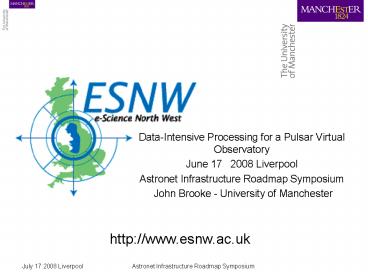DataIntensive Processing for a Pulsar Virtual Observatory - PowerPoint PPT Presentation
1 / 11
Title:
DataIntensive Processing for a Pulsar Virtual Observatory
Description:
Advanced Network technology. Mid range: NW-GRID and local clusters ... Jodrell Bank Radio Observatory searches for fast pulsars in binary systems. ... – PowerPoint PPT presentation
Number of Views:19
Avg rating:3.0/5.0
Title: DataIntensive Processing for a Pulsar Virtual Observatory
1
- Data-Intensive Processing for a Pulsar Virtual
Observatory - June 17 2008 Liverpool
- Astronet Infrastructure Roadmap Symposium
- John Brooke - University of Manchester
http//www.esnw.ac.uk
2
E-Science North-West (ESNW) research
Bio-Medical
Physics and Astronomy
Social science
Chemistry
Semantic and Knowledge Technologies
Database Technologies
Generic Grid and e-Science technologies
3
North-West Gridadvancing Grid Technologies and
Applications
http//www.nw-grid.ac.uk
Hooks to other Grid consortia NGS, WRG
Acknowledgement Rob Allan STFC Daresbury and
NW-GRID consortium.
Top end HPCx
Applications and industry
Pharma, meds, bio, social, env, astro, CCPs
Portals, client toolkits, active overlays
Mid range NW-GRID and local clusters
User interfaces
Sensor networks and experimental facilities
Advanced Network technology
Desktop pools Condor etc.
4
The Jodrell Bank Pulsar Search Code
- Jodrell Bank Radio Observatory searches for fast
pulsars in binary systems. - In order to obtain a high signal-to-noise ratio
they observe across a wide band of radio
frequencies and integrate. - However the interstellar medium is dispersive
(the speed of the radio waves depends on
frequency) - The parameter space is huge, interstellar
dispersion, orbital parameters, acceleration are
unknown. - In searching for candidates we have a very
data-intensive processing task and then the use
of intuition in selecting candidates for further
observation.
5
Dispersion across RF band
Diagram supplied by Michael Kramer Jodrell Bank
Observatory
6
Pulsar Virtual Observatory process
7
Scheduling pipeline
Data
Master
Slaves
8
Architecture for distributed data processing
9
Current status
- Rewrite of pulsar detection tools in Michael
Keiths PhD thesis. Re-analysis of the Parkes
Multi-beam Survey led to the discovery of 30 new
pulsars and re-analysis of the Perseus arm survey
produced 10 more. - An architecture for distributing the searching
algorithms over clusters and computational grids
has been developed in the Grid1D project. Details
at - http//www.rcs.manchester.ac.uk/research/projects
/pulsargrid/ - An extensive search for binary pulsars has been
carried out on NorthGrid. The results are
currently being analyzed.
10
SKA pulsar survey
expect 20000 psrs incl. 1000 MSPs and
BH-pulsar binaries
Thanks to Michael Kramer JBO
11
Pulsar Virtual Observatory
- At present it still requires expertise in pulsar
astronomy to use the searching methods. - The ultimate aim is to automate this process as
much as possible since pulsar searching will
become harder to find fainter pulsars in regions
of high dispersion measure. - Pattern recognition techniques may be able to be
utilised in the candidate identification stage. - Pulsar searching can be linked with observations
at other wavelengths, e.g. X-ray.































